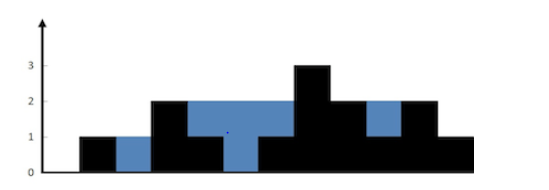Problem description
Given n non-negative integers representing an elevation map where the width of each bar is 1, compute how much water it is able to trap after raining.
Examples
1
2
3
| Example 1:
Input: [0,1,0,2,1,0,1,3,2,1,2,1]
Output: 6
|

Solution
这难道就是一看就懂,一写就懵逼的题目吗?一看就知道是木桶效应,嗯问题来了,咋写呢? 苦思良久,还是看解析吧! 发现博主和我想法不谋而合也是采取了木桶效应。取当前块的左右最大边界中的最低边界min.-当前块的高度。但这样做会超时。可以采用分治策略,先找到最高块高度和索引,分别计算左侧水面积和右侧水面积再相加。以计算左侧面积为例:判读当前块高度currentHeight是否大于maxHeight,为true的话,则累加(maxHeight - currentHeight );
Code
1
2
3
4
5
6
7
8
9
10
11
12
13
14
15
16
17
| class Solution://Shortest barrel
def trap(self, height):
"""
:type height: List[int]
:rtype: int
"""
res, hei_len = 0, len(height)
for i in range(1, hei_len-1):
max_left, max_right = 0, 0
for l in range(i+1):
max_left = max(max_left, height[l])
for r in range(i, hei_len):
max_right = max(max_right, height[r])
res += min(max_left, max_right) - height[i]
return res
|
1
2
3
4
5
6
7
8
9
10
11
12
13
14
15
16
17
18
19
20
21
22
23
24
25
26
27
28
29
30
31
32
33
34
35
| class Solution {
public int trap(int[] height) {
if (height.length == 0 || height.length == 1) {
return 0;
}
int maxHeight = Integer.MIN_VALUE;
int index = 0;
for (int i = 0; i < height.length; i++) {
if (height[i] > maxHeight) {
maxHeight = height[i];
index = i;
}
}
int result = 0, currentMax = Integer.MIN_VALUE;
for (int i = 0; i < index; i++) {
if (currentMax >= height[i]) {
result += currentMax - height[i];
} else {
currentMax = height[i];
}
}
currentMax = Integer.MIN_VALUE;
for (int i = height.length - 1; i > index; i--) {
if (currentMax >= height[i]) {
result += currentMax - height[i];
} else {
currentMax = height[i];
}
}
return result;
}
}
|
